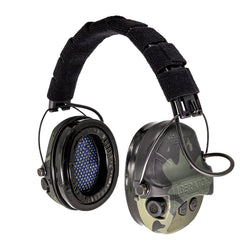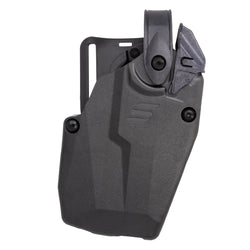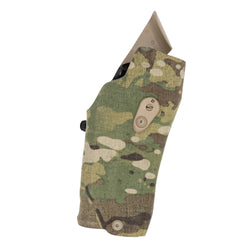As the seasons change, the leaves start falling, and the cool autumn rains make the ground a little softer, your range day packing list is likely going to change a bit, too.
You’re going to ditch the cooling towels and moisture-wicking fishing shirts with those handy cape vents for thicker flannels, jeans, and Gore-Tex-sealed Solomon boots. That’s just the way of things.
But aside from your clothing, it’s not always clear what to pack for the range. Weather conditions can change in an instant, and the challenges of cooler temps, muddy range bays, and other environmental factors can really put a damper on your range training sessions if you’re not fully prepared for it.
Does that necessarily mean you need more gunsmithing tools and special lubricants in your range bag than you normally carry? Or how about high-dollar rain gear and A-tier holster setups?
No. Well, sorta. Maybe, I guess.
Let’s talk about it.
Changing with the Seasons
One of the things we don’t always think about is how much the seasons shape and impact our training. Summer range days are pretty forgiving. You roll up in shorts and a t-shirt, throw your gear on a dry bench, chug a little water, and get to work. Hydrate before you die-drate, I hear some say. But aside from staying hydrated, warding off the UV rays with copious amounts of sunscreen, and taking a bath in permethrin or DEET-rich sprays, there’s not much to it.
Come fall, though, things change up a bit. At least where I live. That shooting bench might be slick with rainwater, and the ground you’re kneeling in is a swampy mess that’ll have you hosing off your boots for days. Cold air takes effect, too, trading ticks, mosquitoes, and other warm-weather pests for stiff fingers and joints, slightly slower draws, and even your reloads seem to take just a little more effort.
It’s not enough to completely wreck your training regimen, but it’s enough to notice. It’s the kind of stuff you laugh about early on, then realize it actually matters when you’re trying to run drills cleanly. Maybe it’s a side-effect of getting older. Or, maybe it’s just the voice of experience. Probably a little of both.
Point being, the changing of seasons isn’t just about swapping those cargo shorts and ventilated fishing shirts for jeans and a flannel. It completely changes how you shoot and, in my opinion, makes you train just a little harder.
Rain or Shine
Rainy days separate the folks who treat range time as a casual hobby from those who mean business. Anybody can shoot when it’s sunny and 75. But when water’s dripping off the brim of your hat, your hands are getting a little cold and pruny, and your gun’s treating itself to a mud bath spa day, that’s when you actually learn something.
You’ll quickly learn that your gear, no matter how much you’ve spent on it, can (and will) fail on you at some point when exposed to the elements. Usually, it’s something minor, like faster battery drain due to the cold, or a few water droplets on your optic. But sometimes, it can cause more serious issues that, if you’re not prepared, could land you in a world of hurt, like waterlogged electronics, jammed actions, or stuck magazine followers.

Training in less-than-perfect conditions forces you to become a better shooter and more proficient tactician, and it gives you a deeper appreciation for how important it is to have multiple redundancies for your gear.
You’ll also learn more about your body and what it takes to stay effective in less-than-ideal conditions. Cold, wet hands are less dexterous. Your joints will feel a little stiffer, and your clothing will feel a little heavier. It forces you to slow down just a little, to be more deliberate with your movements, and to recognize that while speed is important, it is nothing without precision.
Does it suck? Yeah, it can. But it makes you a better, more prepared shooter. Bad guys, deer, or whatever target or threat you’re training for, rarely make their appearances in 70 degrees and under clear skies. Rain teaches you how your gear actually works when it’s messy. Moreover, it makes you more in tune with your body, your habits, and your limits.
Fall training is great because you’ll get the best of both worlds. Rain. Sunshine. Sometimes both. It keeps you on your toes, and when it comes to being a prepared shooter, well, it’s a nice perk.
Lesser-known Environmental Considerations
It’s easy to focus on the big things: rain, cold, and mud. But a fall day at the range can throw a bunch of smaller, sneakier problems your way, too. A little bit of thinking ahead and considering some of these less-obvious factors can make a huge difference in how much you actually get out of your training.
Wind. A stiff autumn breeze can do more than just make you feel a little chilly. It can wreck your accuracy potential, especially at longer distances, where a few miles per hour of crosswind can push your shot completely off target. But on the flip side, what better chance to practice wind calls and holdovers?
Those cool, autumn gusts also force you to refine your fundamental skills a bit. If you’re wobbling in your stance or snatching your trigger press, the wind will make that painfully obvious. Treat it as free feedback provided by Mother Nature herself. If you can hold steady and make clean hits in the breeze, you’ll be that much more solid when conditions are calm.
Humidity and Fog. The combination of cooler temperatures and frequent overnight rain can blanket the range in fog or create a clammy, damp feel that seeps into everything: your gear, your optics, everything. But worse than that constant damp feeling is the ever-present threat of fog.
All too common here in Northern Missouri, dense fog reduces visibility and can make steel targets harder to pick up. Optics can fog over, too, and there’s nothing more frustrating than peering through a milky sight picture. Of course, you can combat some of those threats by keeping some lens cloths handy, learn to run drills in low-contrast conditions, and never assuming that humidity is only a summer problem.
Reduced Light. The days are getting shorter, and that golden evening hour you loved back in July? It’s probably a gray, drizzly half-hour now. This shift is the perfect excuse to push yourself into low-light training. Break out a weapon-mounted light, or if you don’t have one, work on flashlight techniques that keep your support hand free to control recoil.
Further, a reduction in available light forces you to trust your other senses, your muscle memory, and those fundamentals you’ve been drilling all year long. If you can confidently run your gun in dim, fading light, you’re setting yourself up to be much more capable in the real world.
The Packing List
Now that we’ve covered the why, let’s talk about the what. Your fall range bag isn’t a summer bag with a jacket crammed on top. It’s a deliberate setup for different conditions. Here’s a breakdown of what to consider packing.
Outerwear
Your clothing is your first line of defense against the elements, and in the fall, that means a layered approach. Start with a comfortable base layer, followed by a warmer second layer, such as a fleece or wool shirt. It’ll provide insulation without being too bulky. Your final layer should be a durable jacket or windbreaker; something designed to withstand the rough and tumble nature of an intensive training and range day. A good flannel is always a solid option. It’s warm, tough, and stylish.
That’s good enough for me.

That said, be sure to pack a poncho or a range-ready rain jacket. Not because you’re gonna stay dry (you won’t), but because you’ll last longer before you start thinking more about how wet you are than how you’re shooting. Personally, I’m a big fan of my Vortex Cloudshaker rain jacket, but any hooded raincoat will do.
If you’re looking for a specific setup, here’s my go-to:
- 5.11 Tactical PT-R Catalyst Crew (base layer)
- Generic Fleece Long-Sleeve (mid layer)
- Vortex Cloud Shaker Rain Jacket (outer shell)
As for your pants, I tend to stick to my blue jeans, though once they get a little wet, they stay wet. In especially wet environments, I actually prefer a thermal base layer, coupled with quick-dry tactical pants or even some Gore-Tex-treated fatigues. I really think your choice of pants, though, is more of a preference than a necessity. That’s just my opinion.
Gear-wear and Gun Protection
The cool, wet air of fall is a great equalizer. It doesn’t care if you’re running a thousand-dollar rifle or a trusty old Glock; it’s going to test them both.
This is where you earn your keep as a responsible firearm owner. You’ll want to have a cleaning cloth and a bottle of lubricant on hand at the very least. You don’t need a full-blown bench-top kit; just something to wipe the grime off and prevent rust from setting in on the ride home.
Speaking of, a quality gun case matters more now than it did in the summer. That bargain-bin soft case that worked just fine when you were throwing your rifle in the truck bed is going to be a liability. Waterlogged cases can trap moisture against your firearm, leading to corrosion and rust. A hard case with a watertight seal or a quality soft case made from water-resistant material can be the difference between a clean gun and a surprise cleaning project when you get home.

This also applies to your everyday carry. Fall is the perfect time to reconsider your holster material. Leather and some fabric holsters can absorb moisture and hold it against your firearm, which is a recipe for rust. A good quality Kydex or injection-molded holster will shed water and keep your firearm protected.
If you want my advice, look into a purpose-built hard gun case from SKB Cases or Condition 1. While I don’t have a ton of experience with Condition 1 products, I’m a huge fan of SKB Cases’ i-Series line. You just can’t go wrong with any of ’em. But for quick reference, here’s a quick list of a few of my favorites:
- SKB Field-Ready iSeries 4 Rifle Locker
- SKB iSeries 1006-3 Custom Single Pistol Case
- SKB iSeries 2015-10 Eight Handgun Case
Rain Tarps and Pack Covers
And finally, protect your range bag or field pack from the elements at all costs. Our guns and ammo usually get all the attention when it comes to protection, but your range bag takes the brunt of the abuse. Once the ambient moisture or fall rains soak through your bag, you’re not just dealing with damp paper targets anymore. You’re looking at mildew, mold, and a bag that starts to smell like Pee-Wee Herman’s basement.
Not good.

A bag with a built-in or removable rain cover is a wise investment. It’s basically the same concept hikers use, and the payoff is huge. Your range day essentials stay dry, and your gear doesn’t end up smelling funky after one wet afternoon. Even better, your bag lasts longer. Waterlogged nylon and zippers don’t really hold up under those conditions, and replacing a bag every season is a lot pricier than just getting one that can deal with the weather in the first place.
At the end of the day, a dry bag means a dry range session. And nothing cuts a good training day short faster than soggy gear. That said, here are a few of my personal favorites:
The smaller essentials
This is the part of the packing list that gets overlooked more than anything else. Everyone remembers their gun, ammo, and maybe even a spare jacket, but it’s the little things that keep the day from turning miserable when the weather decides to turn on you in an instant. And while I’ve tailored this list of smaller items specifically for fall weather, it can’t hurt to keep ’em in your permanent year-round rotation as well.
Here goes.
Proper Footwear
If there’s one thing that can ruin a good range day faster than bad ammo, it’s wet feet. A personal pet peeve.
Fall weather means mud, puddles, and slick gravel, and whatever you’re wearing on your feet will either make the day tolerable or absolutely miserable. Your everyday tennies might work on dry pavement, but they’ll soak through in the first patch of wet grass. Once your feet are cold and soggy, it’s game over.

This is where a good pair of waterproof boots or Gore-Tex–lined shoes makes all the difference. They give you traction, keep your socks dry, and save you from sliding around like a newborn deer on wet clay.
If you want my advice, look into Salomon or Keen. Both brands make solid boots and trail shoes with Gore-Tex shells that hold up to wet weather without roasting your feet once the sun comes back out. Salomon’s trail running shoes are perfect if you want something lightweight and fast-drying, while Keen leans more toward rugged, all-day comfort. Either way, you’ll be a lot happier standing in the mud with a pair that actually belongs there.
For quick reference, here are a few to check out:
Multi-tools and Oil wipes
Fall range days always come with surprises, including dropped screws, loose mounts, or grit in your mags. A good multi-tool covers all those bases without turning your range bag into a mobile workshop.

Pair that with a couple of oil wipes, and you’ve got yourself a simple kit that keeps dirt, grime, and corrosion-causing moisture at bay.
If you’re interested, here are a few personal faves:
Non-Insulated gloves
Gloves are often an afterthought. Fall isn’t usually cold enough for insulated winter gloves, but a good pair of non-insulated tactical gloves can make your fall shooting experience a hell of a lot more enjoyable, offering protection and a more comfortable grip without frying your hands in a self-imposed sauna once your blood really starts pumping.

The trick is finding gloves that protect without killing dexterity. You need to be able to load mags, manipulate safeties, and adjust optics without peeling them off every five minutes.
If you want my advice, check out Safariland’s Riskmaster MAX Cut-Resistant Gloves for heavy-duty durability, or go with Mechanix Wear tactical gloves for a lighter, more flexible option. I’ve used Mechanix gloves for years, and they’re basically the industry standard at this point. But my Safariland Riskmaster gloves are infinitely more comfortable and super flexible. I suppose it comes down to comfort and personal preference, though, as both will get the job done.
All that said, here’s a quick reference list:
- Mechanix Wear Specialty 0.5mm Covert
- Safariland Riskmaster MAX Gloves
- Mechanix Wear M-Pact Tactical Gloves
Klean Freaks Wipes or Lead-Removal Soap
This last one is probably more important than it sounds, but lead poisoning is no joke.
Baby wipes handle dirt, but they won’t remove lead or carbon buildup from your hands. And that can be a big deal. There’s a reason every reputable manned gun range stocks lead-removing soap in the bathroom.
But if you’re shooting on private property or visiting an unmanned range, Klean Freak body wipes are a great on-the-spot fix, and when you’re back home, a bottle of Hygenall or D-Lead soap finishes the job. It’s a small step that keeps you cleaner and healthier. Plus, those Klean Freak wipes leave your hands smelling pretty dang good. I prefer the “peppermint” scent, but I don’t think you can really go wrong with any of ’em.

Don’t skimp out on it. Use your noggin!
Take a gander at a few options:
TLDR: A Consolidated list
I’m notoriously rather long-winded. Here’s a short, consolidated list for those who prefer to skim:
Outerwear:
- Vortex Cloudshaker Rain Jacket
Weatherproof Gear & Gun Protection:
- SKB iSeries Rifle & Pistol Cases
- Condition 1 Hard Cases
- Kydex holster
Rain Tarps and Pack Covers:
- Safariland Shooter’s Range Backpack
- G.P.S. Tactical Handgunner Backpack
Proper Footwear:
- Keen Targhee III Waterproof Mid
- Salomon XA Forces Mid GTX
- Salomon Speedcross 6 GTX
Multi-Tools and Oil Wipes:
- B5 Systems AR Multi-Tool
- Gerber Suspension-NXT
- Real Avid Gun Oil Wipes
Non-Insulated Gloves:
- Mechanix Wear Specialty 0.5mm Covert
- Safariland Riskmaster MAX
- Mechanix Wear M-Pact Tactical
Hand Wipes & Lead Removal Soap:
- Klean Freak Body Wipes
- D-Lead Hand Soap
- Hygenall Lead-Off Hand Soap
Final Thoughts
Fall range days aren’t inherently harder or less enjoyable than any other time of year. They’re just different. And if you’re prepared and properly equipped, they’re some of the best training days you’ll ever get. Anybody can shoot when it’s 75 and sunny. Not everybody’s willing to drag gear through mud, or face the cool and wet winds, and keep running drills when their fingers are stiff from the cold. That’s the stuff that pays off later.
So no, you don’t need to blow your mortgage payment on a trip to REI or Scheels or what have you . What you need is a change in mindset and a few simple items that will make your time on the range more effective and more enjoyable. When you’re ready to embrace the challenge of fall training, you’ll be a better shooter for it.









